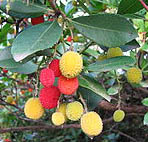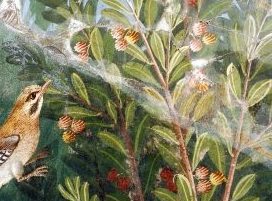
Native to the Mediterranean region and western Europe, this broadleaf evergreen shrub or small tree is a member of the heather family, Ericaceae, that also includes rhododendron, blueberry, and mountain laurel. It is not related to the common strawberry in the genus Fragaria, that is in the rose family. Archaelogical evidence indicates that the strawberry tree grew in the area of ancient Pompeii at the time of the 79 AD eruption of Vesuvius and the plant is frequently shown in the wall paintings of garden scenes in the houses there. The naturalist, Pliny the Elder (d 79 AD) thought that the common strawberry (Fragaris species) that he calls ground-strawberry, and strawberry tree are related. He tells us:
The flesh of the ground-strawberry is very different to that of the arbute-tree, which is of a kindred kind: indeed, this is the only instance in which we find a similar fruit growing upon a tree and on the ground. The tree is tufted and bushy; the fruit takes a year to ripen, the blossoms of the young fruit flowering while that of the preceding year is arriving at maturity. Whether it is the male tree or the female that is unproductive, authors are not generally agreed.
This is a fruit held in no esteem, in proof of which it has gained its name of “unedo,”people being generally content with eating but one.
Pliny is incorrect in mentioning male and female trees as Arbutus has hermaphrodite flowers but he does appreciate that the fruits take a year to ripen and are on the tree when the plant blooms the following year. His etymology of the specific epithet, unedo, is considered fanciful.
It is interesting to note that garden scenes with strawberry trees often include birds. Birds were popular inhabitants in ancient Roman gardens would probably have appreciated the food source that the berries provided.

Description: The plant grows up to 33′ tall and has spreading limbs with exfoliating gray-brown bark that reveals the reddish bark below. As the plant matures the limbs and trunk become gnarled and add an architectural element to the garden. The dark green leaves are glossy, leathery, and are two to four inches long. The white to pink urn-shaped flowers are fragrant and produced in clusters in the fall. Each cluster is two inches long and composed of ten to thirty flowers. The strawberry-like fruits develop over the course of the following year and are ripe in the fall about the same time new flowers are being produced. The berries are enjoyed by birds, can be made into jams and liqueurs, and are valued for their use in flower arrangements especially when used with other fruits. Strawberry tree is an attractive plant and a good choice for Mediterranean or ancient Roman inspired gardens.
Size: 16-33’ H x 16-33’ W
Light: Full sun to part shade except in dessert areas where it tolerates more shade.
Soil: Well drained, limey soil.
Water: Naturally adapted to dry summers; water moderately.
Hardiness: Zones 8-10.